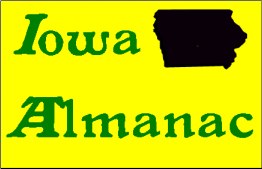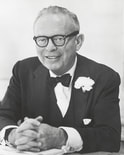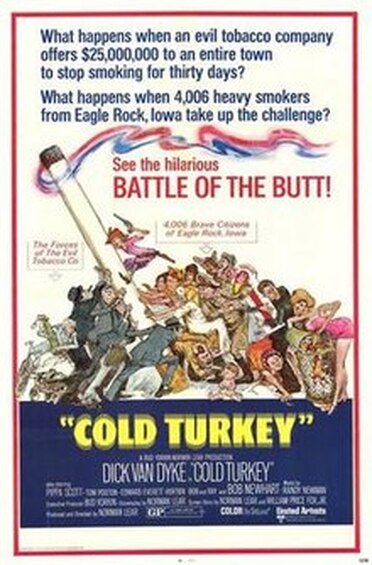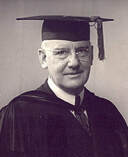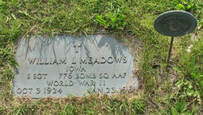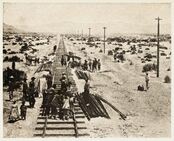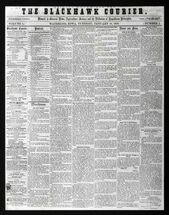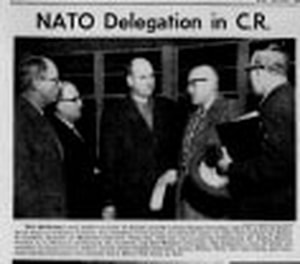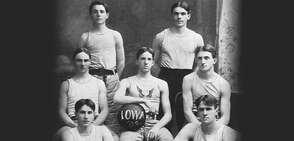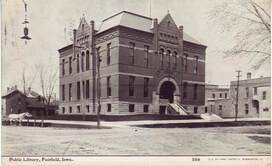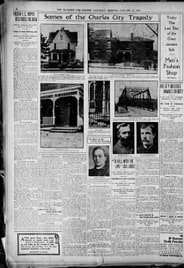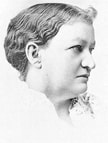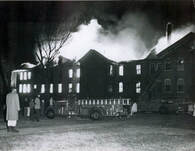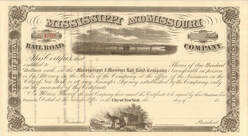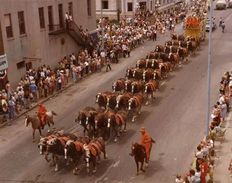"Iowa Almanac" is a copyrighted production of Stein Enterprises, L.L.C.
All Rights Reserved.
No use of the material is allowed without prior written permission of the copyright holder.
Copyright 2019 by Stein Enterprises, L.L.C.
All Rights Reserved.
No use of the material is allowed without prior written permission of the copyright holder.
Copyright 2019 by Stein Enterprises, L.L.C.
Iowa Almanac for Thursday, January 31, 2019
"Mike's LOOK at the World"
A boy was born on January 31st, 1903 in Algona. His father, Gardner Cowles, Sr., named him Gardner Cowles, Jr., but since Senior thought Junior looked Irish, he nicknamed him Mike...and so we know of the work done in publishing and communication by Mike Cowles.
After graduating from Harvard, Mike returned to Iowa in the mid-1920s to begin work at the family-owned newspapers, The Des Moines Register and Tribune. Mike and his older brother John saw the promise of the new medium of radio and aggressively acquired stations in the 1930s. The company's expansion continued in 1935 when the family bought the Minneapolis Star and John moved there to run that, leaving Mike with the Register and Tribune.
In a time before television, there was little way to see newsworthy things. So after consulting research done by University of Iowa graduate student George Gallup, Mike Cowles started LOOK magazine, which first came out in January 1937, just a few months after a similar effort, LIFE magazine, was founded.
During World War II, Mike Cowles took a leave from publishing to become deputy director of the Office of War Information. After the war, he moved to New York to devote his full time to LOOK magazine, while retaining the role of president of the Register and Tribune.
By the mid-1960s, LOOK had passed LIFE in circulation, with a peak of 8.5 million. At that point, Mike's company included Family Circle and other magazines, television stations including TV8 in Des Moines, and a book publisher.
But the advent of television provided moving pictures, and both LOOK and LIFE magazines succumbed to the changing times. LOOK ceased publishing in 1971 despite circulation of 6.5 million.
Mike Cowles' connection to The Des Moines Register literally ran the span of his entire life. His father bought the paper the year he was born, and he died literally one week after the family sold the paper to Gannett in 1985.
Gardner Cowles, Jr.--Mike Cowles--became a global force in publishing from a base in Iowa. And he was born in Algona...on this date in 1903.
And that's Iowa Almanac for January 31st...Listen to the extended audio version of today's story by clicking on the audio player above.
"Mike's LOOK at the World"
A boy was born on January 31st, 1903 in Algona. His father, Gardner Cowles, Sr., named him Gardner Cowles, Jr., but since Senior thought Junior looked Irish, he nicknamed him Mike...and so we know of the work done in publishing and communication by Mike Cowles.
After graduating from Harvard, Mike returned to Iowa in the mid-1920s to begin work at the family-owned newspapers, The Des Moines Register and Tribune. Mike and his older brother John saw the promise of the new medium of radio and aggressively acquired stations in the 1930s. The company's expansion continued in 1935 when the family bought the Minneapolis Star and John moved there to run that, leaving Mike with the Register and Tribune.
In a time before television, there was little way to see newsworthy things. So after consulting research done by University of Iowa graduate student George Gallup, Mike Cowles started LOOK magazine, which first came out in January 1937, just a few months after a similar effort, LIFE magazine, was founded.
During World War II, Mike Cowles took a leave from publishing to become deputy director of the Office of War Information. After the war, he moved to New York to devote his full time to LOOK magazine, while retaining the role of president of the Register and Tribune.
By the mid-1960s, LOOK had passed LIFE in circulation, with a peak of 8.5 million. At that point, Mike's company included Family Circle and other magazines, television stations including TV8 in Des Moines, and a book publisher.
But the advent of television provided moving pictures, and both LOOK and LIFE magazines succumbed to the changing times. LOOK ceased publishing in 1971 despite circulation of 6.5 million.
Mike Cowles' connection to The Des Moines Register literally ran the span of his entire life. His father bought the paper the year he was born, and he died literally one week after the family sold the paper to Gannett in 1985.
Gardner Cowles, Jr.--Mike Cowles--became a global force in publishing from a base in Iowa. And he was born in Algona...on this date in 1903.
And that's Iowa Almanac for January 31st...Listen to the extended audio version of today's story by clicking on the audio player above.
Iowa Almanac for Wednesday, January 30, 2019
"Going Cold Turkey"
The movie's plot was simple: as part of a public relations campaign, an advertising executive comes up with the idea of a tobacco company paying $25 million to any town in America that can stop smoking for 30 days.
The movie was called “Cold Turkey”, and it was filmed in Iowa during the summer of 1969. Stars including Bob Newhart, Dick Van Dyke, Jean Stapleton, Tom Poston, and Barnard Hughes appeared in the film, which was directed by Norman Lear...who would soon go on to create groundbreaking TV sitcoms, including "All in the Family".
The film was set in the fictional small town of Eagle Rock, Iowa, but the filming was actually done in and around Greenfield. The cold turkey campaign turns Eagle Rock into a bickering community...and the story becomes less about smoking and more about the transformation of character brought about by greed.
While the movie was being made, the movie studio's publicity department actually engaged in a real stop smoking campaign in Greenfield. Those who completed the task were awarded "IQ" buttons...standing for "I Quit". The United Artists studio gave the mayor a check for $6,000, which was ultimately used to buy a set of chimes which would ring hourly in the town square.
Dozens of Iowans can be seen in the movie as extras in various scenes. Many of them turned out again in December 2014, when the then 92-year-old Norman Lear returned to Iowa to remember that summer 45 years before, when he directed a movie here. It was the only movie he ever directed, and it earned four stars from acclaimed critic Roger Ebert
It took a while for the distributor to release the film, almost two years after it was made. They weren't sure it would be successful. But audiences loved it...especially the ones who turned out in Des Moines for the movie's world premiere...on this date in 1971.
And that's Iowa Almanac for January 30th...Listen to the extended audio version of today's story by clicking on the audio player above.
"Going Cold Turkey"
The movie's plot was simple: as part of a public relations campaign, an advertising executive comes up with the idea of a tobacco company paying $25 million to any town in America that can stop smoking for 30 days.
The movie was called “Cold Turkey”, and it was filmed in Iowa during the summer of 1969. Stars including Bob Newhart, Dick Van Dyke, Jean Stapleton, Tom Poston, and Barnard Hughes appeared in the film, which was directed by Norman Lear...who would soon go on to create groundbreaking TV sitcoms, including "All in the Family".
The film was set in the fictional small town of Eagle Rock, Iowa, but the filming was actually done in and around Greenfield. The cold turkey campaign turns Eagle Rock into a bickering community...and the story becomes less about smoking and more about the transformation of character brought about by greed.
While the movie was being made, the movie studio's publicity department actually engaged in a real stop smoking campaign in Greenfield. Those who completed the task were awarded "IQ" buttons...standing for "I Quit". The United Artists studio gave the mayor a check for $6,000, which was ultimately used to buy a set of chimes which would ring hourly in the town square.
Dozens of Iowans can be seen in the movie as extras in various scenes. Many of them turned out again in December 2014, when the then 92-year-old Norman Lear returned to Iowa to remember that summer 45 years before, when he directed a movie here. It was the only movie he ever directed, and it earned four stars from acclaimed critic Roger Ebert
It took a while for the distributor to release the film, almost two years after it was made. They weren't sure it would be successful. But audiences loved it...especially the ones who turned out in Des Moines for the movie's world premiere...on this date in 1971.
And that's Iowa Almanac for January 30th...Listen to the extended audio version of today's story by clicking on the audio player above.
Iowa Almanac for Tuesday, January 29, 2019
"The State Historian"
A certain boy, born on this date in 1871 in Elvira, Iowa, had a lot to live up to. He was given the grand name Benjamin Franklin Shambaugh. But he himself became an historic figure in Iowa.
Ben Shambaugh was a professor at the State University of Iowa in Iowa City for 44 years, from 1896 until his death in 1940. From 1900-on, he was head of the university's political science department.
His love of politics and history led to another role...as superintendent and editor at the State Historical Society of Iowa in Iowa City from 1907 to 1940.
During his leadership, the Iowa political science program came of age, producing scholarly research and articles, many focusing on local government in Iowa. And Shambaugh was a leading force in research focusing on trends and tendencies...a scientific approach toward the study of politics and government.
Benjamin Shambaugh and his wife Bertha were well known on campus for their generosity and hospitality. They bequeathed their spacious home on Clinton Street to the University, and it has since been home to the Honors Center, the International Center, and currently, the International Writing Program.
There has been a Shambaugh Auditorium on campus...a university Shambaugh lecture series...and the author of the most significant book published each year on Iowa history receives the coveted Benjamin F. Shambaugh Award. That's consistent with his vision, that historians should apply their knowledge outside the academic community, in pursuit of the greater public good.
The noted historian and professor Benjamin Franklin Shambaugh...born in Elvira, Iowa, on this date in 1871.
And that's Iowa Almanac for January 29th...Listen to the extended audio version of today's story by clicking on the audio player above.
"The State Historian"
A certain boy, born on this date in 1871 in Elvira, Iowa, had a lot to live up to. He was given the grand name Benjamin Franklin Shambaugh. But he himself became an historic figure in Iowa.
Ben Shambaugh was a professor at the State University of Iowa in Iowa City for 44 years, from 1896 until his death in 1940. From 1900-on, he was head of the university's political science department.
His love of politics and history led to another role...as superintendent and editor at the State Historical Society of Iowa in Iowa City from 1907 to 1940.
During his leadership, the Iowa political science program came of age, producing scholarly research and articles, many focusing on local government in Iowa. And Shambaugh was a leading force in research focusing on trends and tendencies...a scientific approach toward the study of politics and government.
Benjamin Shambaugh and his wife Bertha were well known on campus for their generosity and hospitality. They bequeathed their spacious home on Clinton Street to the University, and it has since been home to the Honors Center, the International Center, and currently, the International Writing Program.
There has been a Shambaugh Auditorium on campus...a university Shambaugh lecture series...and the author of the most significant book published each year on Iowa history receives the coveted Benjamin F. Shambaugh Award. That's consistent with his vision, that historians should apply their knowledge outside the academic community, in pursuit of the greater public good.
The noted historian and professor Benjamin Franklin Shambaugh...born in Elvira, Iowa, on this date in 1871.
And that's Iowa Almanac for January 29th...Listen to the extended audio version of today's story by clicking on the audio player above.
Iowa Almanac for Monday, January 28, 2019
"The Capital Gets Its Name"
We all know Des Moines as Iowa's largest city, and the state capital. But its beginnings were far more humble.
Back in May of 1843, Captain James Allen supervised the construction of a fort where the Des Moines and Raccoon Rivers merge. Captain Allen wanted to call it Fort Raccoon...but the U.S. War Department overruled him, and declared the structure to be known as Fort Des Moines.
Archaeological excavations have found many fort-related features survived under what is now Martin Luther King Jr. Parkway and First Street in Des Moines.
In May of 1851, much of the town surrounding the fort was destroyed by floods. The devastation was complete, allowing in essence a clean slate on which a new city could be built. That city was incorporated in the fall of 1851 as Fort Des Moines.
At that time, there were only 3,500 residents living in about 500 dwellings. But the city grew, with an official population of 203,433 in the last census. Being the state capital obviously helped in the city's growth. The state capital moved from Iowa City to Des Moines by declaration of Governor James Grimes in 1857.
Notice I said "Des Moines"...that's because shortly before the governor declared the city to be the state's capital city, the name "Fort Des Moines" was shortened to, simply "Des Moines".
Imagine if Captain James Allen had gotten his way when the original fort was built...Iowa's capital city might be known as Raccoon. But it's not...and the city became known as "Des Moines" on this date in 1857.
And that's Iowa Almanac for January 28th...Listen to the extended audio version of today's story by clicking on the audio player above.
"The Capital Gets Its Name"
We all know Des Moines as Iowa's largest city, and the state capital. But its beginnings were far more humble.
Back in May of 1843, Captain James Allen supervised the construction of a fort where the Des Moines and Raccoon Rivers merge. Captain Allen wanted to call it Fort Raccoon...but the U.S. War Department overruled him, and declared the structure to be known as Fort Des Moines.
Archaeological excavations have found many fort-related features survived under what is now Martin Luther King Jr. Parkway and First Street in Des Moines.
In May of 1851, much of the town surrounding the fort was destroyed by floods. The devastation was complete, allowing in essence a clean slate on which a new city could be built. That city was incorporated in the fall of 1851 as Fort Des Moines.
At that time, there were only 3,500 residents living in about 500 dwellings. But the city grew, with an official population of 203,433 in the last census. Being the state capital obviously helped in the city's growth. The state capital moved from Iowa City to Des Moines by declaration of Governor James Grimes in 1857.
Notice I said "Des Moines"...that's because shortly before the governor declared the city to be the state's capital city, the name "Fort Des Moines" was shortened to, simply "Des Moines".
Imagine if Captain James Allen had gotten his way when the original fort was built...Iowa's capital city might be known as Raccoon. But it's not...and the city became known as "Des Moines" on this date in 1857.
And that's Iowa Almanac for January 28th...Listen to the extended audio version of today's story by clicking on the audio player above.
Iowa Almanac for Friday, January 25, 2019
"Protecting the Public from Victimization"
The Iowa Territory was established in 1838. Soon after, on January 25th, 1839, in order to ensure the safety of the citizens of the new territory, the Territorial Legislature, meeting in Burlington, passed a law establishing creation of a penitentiary along the Mississippi River.
They initially approved $20,000 for the new facility, which was to be built on ten acres of land donated by the citizens of Fort Madison. The facility was to be able to receive, secure, and employ 136 convicts.
Obviously, it took a while to construct such a facility, so Iowa's first prison was actually, literally, a hole in the ground under the floor of the warden's residence. Little surprise that seven of the first eleven prisoners escaped.
Construction of the first cellhouse, which came to be known as Cellhouse 17, was completed in October of 1841 at a cost of $56,000. When Iowa became a state five years later, the legislature approved enlarging the prison. By 1854, Cellhouse 17 contained 133 cells.
The original facility was a two-story sandstone cell block. It was designed to house those convicted of the most serious offenses against society. A third story was added to the building in the 1870s. Additional buildings and cellhouses, as well as a large sandstone wall with regularly placed gun towers, were added as the number of inmates increased.
After 175 years, the Iowa State Penitentiary closed its original facility not long ago. Inmates were transferred from the old prison to the new one in August 2015, roughly a year behind schedule due to well-publicized construction issues. The state offered to transfer ownership of the penitentiary to the city of Fort Madison, so it could be turned into a museum.
That new prison cost more than $130 million to build. The first appropriation for a state prison was far less, only $20,000, when the Iowa legislature passed a law establishing the Iowa State Penitentiary in Fort Madison, on this date in 1839…180 years ago today.
And that's Iowa Almanac for January 25th...Listen to the extended audio version of today's story by clicking on the audio player above.
"Protecting the Public from Victimization"
The Iowa Territory was established in 1838. Soon after, on January 25th, 1839, in order to ensure the safety of the citizens of the new territory, the Territorial Legislature, meeting in Burlington, passed a law establishing creation of a penitentiary along the Mississippi River.
They initially approved $20,000 for the new facility, which was to be built on ten acres of land donated by the citizens of Fort Madison. The facility was to be able to receive, secure, and employ 136 convicts.
Obviously, it took a while to construct such a facility, so Iowa's first prison was actually, literally, a hole in the ground under the floor of the warden's residence. Little surprise that seven of the first eleven prisoners escaped.
Construction of the first cellhouse, which came to be known as Cellhouse 17, was completed in October of 1841 at a cost of $56,000. When Iowa became a state five years later, the legislature approved enlarging the prison. By 1854, Cellhouse 17 contained 133 cells.
The original facility was a two-story sandstone cell block. It was designed to house those convicted of the most serious offenses against society. A third story was added to the building in the 1870s. Additional buildings and cellhouses, as well as a large sandstone wall with regularly placed gun towers, were added as the number of inmates increased.
After 175 years, the Iowa State Penitentiary closed its original facility not long ago. Inmates were transferred from the old prison to the new one in August 2015, roughly a year behind schedule due to well-publicized construction issues. The state offered to transfer ownership of the penitentiary to the city of Fort Madison, so it could be turned into a museum.
That new prison cost more than $130 million to build. The first appropriation for a state prison was far less, only $20,000, when the Iowa legislature passed a law establishing the Iowa State Penitentiary in Fort Madison, on this date in 1839…180 years ago today.
And that's Iowa Almanac for January 25th...Listen to the extended audio version of today's story by clicking on the audio player above.
Iowa Almanac for Thursday, January 24, 2019
"A Favorite Treat"
Christian Nelson emigrated to Iowa from Denmark. By the time he was 27 years of age, he was living in Onawa, population 2,919. He had been a school teacher and now owned a candy store.
One day in 1920, a young customer could not decide whether to buy ice cream or a chocolate bar. He only had enough money for one or the other. That gave Christian Nelson an idea.
After several experiments, he developed a way to make melted chocolate stick to a block of ice cream. He called them I-Scream Bars, a play on the words ice cream. The idea quickly took off, with other stores in Iowa selling the treats by the next year.
Nelson partnered with a chocolate producer he had met in Iowa City named Russell Stover to help mass produce the product. Russell Stover's wife Clara came up with a new name for the treat--the Eskimo Pie.
It was such a huge success, the factory could not keep up with demand, so Nelson licensed the product to others across the country. Within the first year, Nelson and Stover were receiving $30,000 a week in royalties...one million Eskimo Pies were sold every day.
Stover sold his share to Nelson and founded his own candy business, of course. Nelson ultimately sold his share to the company that made the Eskimo Pie wrappers, but he quickly became bored and went back to work, inventing new ways of manufacturing and shipping his product.
They were created because a young boy could not decide whether to buy ice cream or chocolate. And the patent for Eskimo Pies was granted to Iowan Christian Nelson, on this date, in 1922.
And that's Iowa Almanac for January 24th...Listen to the extended audio version of today's story by clicking on the audio player above.
"A Favorite Treat"
Christian Nelson emigrated to Iowa from Denmark. By the time he was 27 years of age, he was living in Onawa, population 2,919. He had been a school teacher and now owned a candy store.
One day in 1920, a young customer could not decide whether to buy ice cream or a chocolate bar. He only had enough money for one or the other. That gave Christian Nelson an idea.
After several experiments, he developed a way to make melted chocolate stick to a block of ice cream. He called them I-Scream Bars, a play on the words ice cream. The idea quickly took off, with other stores in Iowa selling the treats by the next year.
Nelson partnered with a chocolate producer he had met in Iowa City named Russell Stover to help mass produce the product. Russell Stover's wife Clara came up with a new name for the treat--the Eskimo Pie.
It was such a huge success, the factory could not keep up with demand, so Nelson licensed the product to others across the country. Within the first year, Nelson and Stover were receiving $30,000 a week in royalties...one million Eskimo Pies were sold every day.
Stover sold his share to Nelson and founded his own candy business, of course. Nelson ultimately sold his share to the company that made the Eskimo Pie wrappers, but he quickly became bored and went back to work, inventing new ways of manufacturing and shipping his product.
They were created because a young boy could not decide whether to buy ice cream or chocolate. And the patent for Eskimo Pies was granted to Iowan Christian Nelson, on this date, in 1922.
And that's Iowa Almanac for January 24th...Listen to the extended audio version of today's story by clicking on the audio player above.
Iowa Almanac for Wednesday, January 23, 2019
"An Officer's Murder Remains Unsolved"
Mr. and Mrs. Ernest Buckman operated a drug store in the Bremer County town of Plainfield and lived in the upstairs of the building. Just after 2 a.m. on January 23rd, 1961, Mrs. Buckman heard a loud noise that sounded like an explosion. When she looked out the window, she saw someone moving around inside the packing plant across the street. So she called town marshal William Meadows, as well as the family members who operated the packing plant.
Thieves had broken the lock on the front door of the building, and were still trying to crack the safe in the company's office when Marshal Bill Meadows entered the building. One of the thieves fired a high powered 30-30 deer rifle...the bullet went completely through the 36-year-old officer's body, and he fell, barely three feet inside the doorway.
Just then, one of those who operated the plant, Ted Hartmann, arrived and was coming toward the door. Another shot rang out, this one shattering the building’s front glass and barely missing Hartmann's head.
Someone yelled, "Stay where you are, or you'll be shot, too." The thieves continued shooting until both of them exited the building. Despite a $500 reward offered by Iowa Gov. Norman Erbe, the burglars were never found.
In 2009, the Iowa Division of Criminal Investigation started a Cold Case Unit. Marshal Meadows' murder was one of about 150 cases the DCI hoped to solve using the latest advancements in DNA technology, but were unable.
One more thing...the burglars were using explosives to open the cash compartment of a safe, hoping for an easy score. They shouldn't have bothered; the compartment contained only documents...the cash had been taken to the bank earlier in the day.
And we still don't know who killed a Plainfield officer in the line of duty, on this date, in 1961.
And that's Iowa Almanac for January 23rd...Listen to the extended audio version of today's story by clicking on the audio player above.
"An Officer's Murder Remains Unsolved"
Mr. and Mrs. Ernest Buckman operated a drug store in the Bremer County town of Plainfield and lived in the upstairs of the building. Just after 2 a.m. on January 23rd, 1961, Mrs. Buckman heard a loud noise that sounded like an explosion. When she looked out the window, she saw someone moving around inside the packing plant across the street. So she called town marshal William Meadows, as well as the family members who operated the packing plant.
Thieves had broken the lock on the front door of the building, and were still trying to crack the safe in the company's office when Marshal Bill Meadows entered the building. One of the thieves fired a high powered 30-30 deer rifle...the bullet went completely through the 36-year-old officer's body, and he fell, barely three feet inside the doorway.
Just then, one of those who operated the plant, Ted Hartmann, arrived and was coming toward the door. Another shot rang out, this one shattering the building’s front glass and barely missing Hartmann's head.
Someone yelled, "Stay where you are, or you'll be shot, too." The thieves continued shooting until both of them exited the building. Despite a $500 reward offered by Iowa Gov. Norman Erbe, the burglars were never found.
In 2009, the Iowa Division of Criminal Investigation started a Cold Case Unit. Marshal Meadows' murder was one of about 150 cases the DCI hoped to solve using the latest advancements in DNA technology, but were unable.
One more thing...the burglars were using explosives to open the cash compartment of a safe, hoping for an easy score. They shouldn't have bothered; the compartment contained only documents...the cash had been taken to the bank earlier in the day.
And we still don't know who killed a Plainfield officer in the line of duty, on this date, in 1961.
And that's Iowa Almanac for January 23rd...Listen to the extended audio version of today's story by clicking on the audio player above.
Iowa Almanac for Tuesday, January 22, 2019
"Connecting the Rails"
The middle part of the 1800s saw the growth of railroad construction in America. Lines connecting various points in Iowa to one another aided in transporting goods and people. But it was the building of the transcontinental railroad that spurred completion of the main rail lines in our state.
The two major Iowa lines…the Cedar Rapids and Missouri River Railroad, and the Mississippi and Missouri…each wanted to be the connecting link between the Union Pacific to the west, and the Chicago to the east.
Under the leadership of promoter John Blair, the CR & MR moved ahead, starting west of Boone in late 1865…reaching Denison by the next spring…then continuing to move westward the rest of that year. Finally, crews laid the last rail in front of the new station in Council Bluffs on this date in 1867. And with that, Council Bluffs had a complete rail route eastward to Chicago. It would be another two years before Leland Stanford drove the ceremonial golden spike into the Utah ground, joining the rails of the original transcontinental railroad.
As for the Mississippi and Missouri…that line was taken over by the Rock Island, and did not reach Council Bluffs until May…two years later. The Cedar Rapids and Missouri River would later become the Chicago and North Western.
The desire to connect railroads westward across Iowa led to another development…the city of Ames, which was chartered in 1864 for the railroad, and named by CR & MR president John Blair after a Massachusetts congressman, Oakes Ames.
But Council Bluffs became the eastern terminus of the First Transcontinental Railroad, when the last spike was driven, and the rail line from there to Chicago was completed, on this date in 1867.
And that's Iowa Almanac for January 22nd...Listen to the extended audio version of today's story by clicking on the audio player above.
"Connecting the Rails"
The middle part of the 1800s saw the growth of railroad construction in America. Lines connecting various points in Iowa to one another aided in transporting goods and people. But it was the building of the transcontinental railroad that spurred completion of the main rail lines in our state.
The two major Iowa lines…the Cedar Rapids and Missouri River Railroad, and the Mississippi and Missouri…each wanted to be the connecting link between the Union Pacific to the west, and the Chicago to the east.
Under the leadership of promoter John Blair, the CR & MR moved ahead, starting west of Boone in late 1865…reaching Denison by the next spring…then continuing to move westward the rest of that year. Finally, crews laid the last rail in front of the new station in Council Bluffs on this date in 1867. And with that, Council Bluffs had a complete rail route eastward to Chicago. It would be another two years before Leland Stanford drove the ceremonial golden spike into the Utah ground, joining the rails of the original transcontinental railroad.
As for the Mississippi and Missouri…that line was taken over by the Rock Island, and did not reach Council Bluffs until May…two years later. The Cedar Rapids and Missouri River would later become the Chicago and North Western.
The desire to connect railroads westward across Iowa led to another development…the city of Ames, which was chartered in 1864 for the railroad, and named by CR & MR president John Blair after a Massachusetts congressman, Oakes Ames.
But Council Bluffs became the eastern terminus of the First Transcontinental Railroad, when the last spike was driven, and the rail line from there to Chicago was completed, on this date in 1867.
And that's Iowa Almanac for January 22nd...Listen to the extended audio version of today's story by clicking on the audio player above.
Iowa Almanac for Monday, January 21, 2019
"A Secret Society Is Formed"
There's some pressure among college students today to get into the "right" fraternity or sorority. Not being invited to join can have an effect on a young person.
Back in 1869, sororities were not common...in fact, there was only one in existence in the country, now known as Pi Beta Phi. At Iowa Wesleyan College in Mount Pleasant, there was a new chapter of that sorority, and seven close friends were among those who wanted to be the first members. But when invitations went out, not all of the seven were included.
Not wanting anything to come between their friendship, the seven decided to form their own sisterhood. Hattie Briggs and Franc (Frances) Roads came up with the idea, and soon enlisted Allie Bird, Ella Stewart, Mary Allen, Suela Pearson, and Alice Coffin in the cause.
They called it the P.E.O. Sisterhood, and for more than a century, the meaning of P.E.O. was an official secret. In 2008, the group's website indicated that the letters stand for Philanthropic Educational Organization.
Today, that original membership of 7 women on one Iowa campus has grown to nearly a quarter of a million members in chapters throughout the U.S. and Canada, with headquarters in Des Moines. The second sorority to be founded in the country now sponsors six international projects to help women with their educational goals.
And it all started when seven young women decided not to join an Iowa Wesleyan sorority that wouldn't take their friends as well...choosing friendship over membership...on this date, in 1869…150 years ago today.
And that's Iowa Almanac for January 21st...Listen to the extended audio version of today's story by clicking on the audio player above.
"A Secret Society Is Formed"
There's some pressure among college students today to get into the "right" fraternity or sorority. Not being invited to join can have an effect on a young person.
Back in 1869, sororities were not common...in fact, there was only one in existence in the country, now known as Pi Beta Phi. At Iowa Wesleyan College in Mount Pleasant, there was a new chapter of that sorority, and seven close friends were among those who wanted to be the first members. But when invitations went out, not all of the seven were included.
Not wanting anything to come between their friendship, the seven decided to form their own sisterhood. Hattie Briggs and Franc (Frances) Roads came up with the idea, and soon enlisted Allie Bird, Ella Stewart, Mary Allen, Suela Pearson, and Alice Coffin in the cause.
They called it the P.E.O. Sisterhood, and for more than a century, the meaning of P.E.O. was an official secret. In 2008, the group's website indicated that the letters stand for Philanthropic Educational Organization.
Today, that original membership of 7 women on one Iowa campus has grown to nearly a quarter of a million members in chapters throughout the U.S. and Canada, with headquarters in Des Moines. The second sorority to be founded in the country now sponsors six international projects to help women with their educational goals.
And it all started when seven young women decided not to join an Iowa Wesleyan sorority that wouldn't take their friends as well...choosing friendship over membership...on this date, in 1869…150 years ago today.
And that's Iowa Almanac for January 21st...Listen to the extended audio version of today's story by clicking on the audio player above.
Iowa Almanac for Friday, January 18, 2019
"Starting The Presses"
Iowa had barely been a state for a dozen years when a new weekly publication was born in Waterloo.
It was called The Blackhawk Courier, and the first issue was published on January 18, 1859. Published on Tuesday evenings, the newspaper was founded by W.H. Hartman and George Ingersoll. Subscriptions went for $1.50 per year, payable in advance.
Under the masthead on the front page, the new newspaper declared itself to be "devoted to general news, agriculture, science and the diffusion of Republican principles". The Republican Party was not even five years old at the time, having been founded in Iowa in 1854, but it was growing in popularity. The Republicans elected their first president just one year later in 1860--Abraham Lincoln.
That first edition of the paper featured headings for front page stories such as House and Farm, Poetical, and Miscellaneous. Stories on that first front page included information about the penalties of slave trading, how to properly ascertain the gross and net weight of swine, the production of sorghum in Iowa, and a new law regulating elections that were tied to schools.
The Blackhawk Courier was a weekly until 1890, when it began publishing on weekday afternoons. The name of the paper changed over time, as well, to the Waterloo Evening Courier and Waterloo Daily Courier. For a while after a merger with a newspaper in Cedar Falls, the official name was Waterloo-Cedar Falls Courier, but we now know it as simply The Courier, published with a circulation of nearly 40,000 on weekday afternoons and a few thousand more than that on Sunday mornings.
But that first edition, of the weekly Blackhawk Courier, was published on this date in 1859…160 years ago today.
And that's Iowa Almanac for January 18th...Listen to the extended audio version of today's story by clicking on the audio player above.
"Starting The Presses"
Iowa had barely been a state for a dozen years when a new weekly publication was born in Waterloo.
It was called The Blackhawk Courier, and the first issue was published on January 18, 1859. Published on Tuesday evenings, the newspaper was founded by W.H. Hartman and George Ingersoll. Subscriptions went for $1.50 per year, payable in advance.
Under the masthead on the front page, the new newspaper declared itself to be "devoted to general news, agriculture, science and the diffusion of Republican principles". The Republican Party was not even five years old at the time, having been founded in Iowa in 1854, but it was growing in popularity. The Republicans elected their first president just one year later in 1860--Abraham Lincoln.
That first edition of the paper featured headings for front page stories such as House and Farm, Poetical, and Miscellaneous. Stories on that first front page included information about the penalties of slave trading, how to properly ascertain the gross and net weight of swine, the production of sorghum in Iowa, and a new law regulating elections that were tied to schools.
The Blackhawk Courier was a weekly until 1890, when it began publishing on weekday afternoons. The name of the paper changed over time, as well, to the Waterloo Evening Courier and Waterloo Daily Courier. For a while after a merger with a newspaper in Cedar Falls, the official name was Waterloo-Cedar Falls Courier, but we now know it as simply The Courier, published with a circulation of nearly 40,000 on weekday afternoons and a few thousand more than that on Sunday mornings.
But that first edition, of the weekly Blackhawk Courier, was published on this date in 1859…160 years ago today.
And that's Iowa Almanac for January 18th...Listen to the extended audio version of today's story by clicking on the audio player above.
Iowa Almanac for Thursday, January 17, 2019
"The World Comes to Cedar Rapids"
It was chosen as the city to represent American life. When 10 visiting NATO parliamentary delegates embarked on a 31-day visit of the United States under the auspices of the State Department, Cedar Rapids was picked as the place they would stay the longest.
The delegates from seven countries arrived in Cedar Rapids on January 17th, 1958 for a four-day stay. According to one, they had already seen "defense and politics", but came to Iowa to see "grass roots".
Industrial tours were set up for day one, following by agricultural visits, and a day at Coe College.
The tour members watched automatic packaging lines at Quaker Oats, described by news accounts as "a bunch of boys intrigued by an electric train". They later toured the Cherry-Burrell plant, watching the making of equipment for the dairy and bottling industries, as well as Square D, makers of electronic equipment, and the Iowa Manufacturing Company, to see manufacturing of rock crushers and road building equipment.
The visitors held positions in their own countries similar to that of U.S. congressmen. Canada, Denmark, Germany, France, Italy, England and Iceland were represented. Governor Herschel Loveless and members of the board of the Chamber of Commerce lunched with the NATO delegation at the Roosevelt Hotel downtown.
One member of the Danish parliament, A. C. Normann, said he was impressed by the "open heartedness" of Americans. That was on display when 10 NATO delegates arrived for a four-day stay in Cedar Rapids, on this date in 1958.
And that's Iowa Almanac for January 17th...Listen to the extended audio version of today's story by clicking on the audio player above.
"The World Comes to Cedar Rapids"
It was chosen as the city to represent American life. When 10 visiting NATO parliamentary delegates embarked on a 31-day visit of the United States under the auspices of the State Department, Cedar Rapids was picked as the place they would stay the longest.
The delegates from seven countries arrived in Cedar Rapids on January 17th, 1958 for a four-day stay. According to one, they had already seen "defense and politics", but came to Iowa to see "grass roots".
Industrial tours were set up for day one, following by agricultural visits, and a day at Coe College.
The tour members watched automatic packaging lines at Quaker Oats, described by news accounts as "a bunch of boys intrigued by an electric train". They later toured the Cherry-Burrell plant, watching the making of equipment for the dairy and bottling industries, as well as Square D, makers of electronic equipment, and the Iowa Manufacturing Company, to see manufacturing of rock crushers and road building equipment.
The visitors held positions in their own countries similar to that of U.S. congressmen. Canada, Denmark, Germany, France, Italy, England and Iceland were represented. Governor Herschel Loveless and members of the board of the Chamber of Commerce lunched with the NATO delegation at the Roosevelt Hotel downtown.
One member of the Danish parliament, A. C. Normann, said he was impressed by the "open heartedness" of Americans. That was on display when 10 NATO delegates arrived for a four-day stay in Cedar Rapids, on this date in 1958.
And that's Iowa Almanac for January 17th...Listen to the extended audio version of today's story by clicking on the audio player above.
Iowa Almanac for Wednesday, January 16, 2019
"Basketball in Iowa City"
When you think of basketball at the University of Iowa, Carver-Hawkeye Arena or the Field House come to mind. But the history of basketball there goes back to the very beginning of the sport.
On this date in 1896, University of Iowa physical education instructor Henry Kallenberg welcomed Amos Alonzo Stagg to campus. Stagg was athletic director at the recently founded University of Chicago. The purpose…an experimental game in a new sport.
Kallenberg had met Stagg at a YMCA training school in Massachusetts back in 1890. The next year, that school’s director of physical education invented a new game called basketball. That, of course, was Canadian-born James Naismith.
Through those connections, basketball came to Iowa City. Initially, players passed a soccer ball up and down the court. Points were earned by landing the ball in a peach basket. By 1893, iron hoops and a hammock style basket were introduced. It would take another decade before open-ended nets were added, so until the early 1900s, the ball had to be manually retrieved from the basket each time a goal was scored.
And so it was in Iowa City in 1896…the University of Iowa’s Kallenberg refereed the game. The University of Chicago won, 15 to 12. The game is historic, not for its score…but because it was the first unofficial college basketball game played with five players on each side, the standard we all know today. And it was played in Iowa City on this date in 1896.
(The picture above is from the Iowa collegiate team, circa 1902.)
And that's Iowa Almanac for January 16th...Listen to the extended audio version of today's story by clicking on the audio player above.
"Basketball in Iowa City"
When you think of basketball at the University of Iowa, Carver-Hawkeye Arena or the Field House come to mind. But the history of basketball there goes back to the very beginning of the sport.
On this date in 1896, University of Iowa physical education instructor Henry Kallenberg welcomed Amos Alonzo Stagg to campus. Stagg was athletic director at the recently founded University of Chicago. The purpose…an experimental game in a new sport.
Kallenberg had met Stagg at a YMCA training school in Massachusetts back in 1890. The next year, that school’s director of physical education invented a new game called basketball. That, of course, was Canadian-born James Naismith.
Through those connections, basketball came to Iowa City. Initially, players passed a soccer ball up and down the court. Points were earned by landing the ball in a peach basket. By 1893, iron hoops and a hammock style basket were introduced. It would take another decade before open-ended nets were added, so until the early 1900s, the ball had to be manually retrieved from the basket each time a goal was scored.
And so it was in Iowa City in 1896…the University of Iowa’s Kallenberg refereed the game. The University of Chicago won, 15 to 12. The game is historic, not for its score…but because it was the first unofficial college basketball game played with five players on each side, the standard we all know today. And it was played in Iowa City on this date in 1896.
(The picture above is from the Iowa collegiate team, circa 1902.)
And that's Iowa Almanac for January 16th...Listen to the extended audio version of today's story by clicking on the audio player above.
Iowa Almanac for Tuesday, January 15, 2019
"It's The Oldest Of Its Kind"
The city of Fairfield has a long history when it comes to libraries. The first library there dates back to 1852 when some of the town’s prominent citizens founded the Jefferson County Library Association. But for 40 years, the collection of 500 volumes moved around a lot from one location to another.
In 1891, Senator James Falconer Wilson of Fairfield approached the Pittsburgh steel-industry magnate Andrew Carnegie, to ask for help in building a permanent library for Fairfield.
Carnegie was already known for funding some libraries, but this one would be different. You see, Andrew Carnegie didn’t have any ties to Fairfield and had never visited there. His other donations were to places he had personally seen.
But Wilson was persuasive, and on January 15, 1892, Carnegie pledged $30,000 for a library in Fairfield. Wilson himself donated the land, and the next year, the permanent Jefferson County Library opened.
That library in Fairfield served the town well for almost a hundred years…a new library was built in 1996, and the building Carnegie supported now is operated by Indian Hills Community College.
That gift to Fairfield was the first for a library west of Pittsburgh, then known as Allegheny City. But it was even more than that. It was the gift that started one of the more remarkable funding efforts ever. Between 1892 and 1917, Carnegie provided grants for 1,689 public library buildings in the U.S., at a cost of 41 and a half million dollars. Iowa cities took advantage, and by 1918, Carnegie had provided funds for 97 of the 136 public libraries in our state…Waterloo and Sioux City, in fact, each received grants for 2 libraries in their respective cities.
Worldwide, the massive Carnegie library project supported more than 28-hundred libraries…but it all started with a grant to Fairfield, on this date in 1892.
And that's Iowa Almanac for January 15th...Listen to the extended audio version of today's story by clicking on the audio player above.
"It's The Oldest Of Its Kind"
The city of Fairfield has a long history when it comes to libraries. The first library there dates back to 1852 when some of the town’s prominent citizens founded the Jefferson County Library Association. But for 40 years, the collection of 500 volumes moved around a lot from one location to another.
In 1891, Senator James Falconer Wilson of Fairfield approached the Pittsburgh steel-industry magnate Andrew Carnegie, to ask for help in building a permanent library for Fairfield.
Carnegie was already known for funding some libraries, but this one would be different. You see, Andrew Carnegie didn’t have any ties to Fairfield and had never visited there. His other donations were to places he had personally seen.
But Wilson was persuasive, and on January 15, 1892, Carnegie pledged $30,000 for a library in Fairfield. Wilson himself donated the land, and the next year, the permanent Jefferson County Library opened.
That library in Fairfield served the town well for almost a hundred years…a new library was built in 1996, and the building Carnegie supported now is operated by Indian Hills Community College.
That gift to Fairfield was the first for a library west of Pittsburgh, then known as Allegheny City. But it was even more than that. It was the gift that started one of the more remarkable funding efforts ever. Between 1892 and 1917, Carnegie provided grants for 1,689 public library buildings in the U.S., at a cost of 41 and a half million dollars. Iowa cities took advantage, and by 1918, Carnegie had provided funds for 97 of the 136 public libraries in our state…Waterloo and Sioux City, in fact, each received grants for 2 libraries in their respective cities.
Worldwide, the massive Carnegie library project supported more than 28-hundred libraries…but it all started with a grant to Fairfield, on this date in 1892.
And that's Iowa Almanac for January 15th...Listen to the extended audio version of today's story by clicking on the audio player above.
Iowa Almanac for Monday, January 14, 2019
"The Undefeated Champions"
There has only been one national football league team in history that has won the Super Bowl as an undefeated champion. The Miami Dolphins capped their 1972 perfect regular season with a win in Super Bowl 7 on this date in 1973.
One of the stalwarts on that team was a young man from Iowa…Vern Den Herder.
Born in LeMars in 1948, the Sioux Center high school graduate played his college football at Central in Pella. He was a 9th round draft pick for Miami, back when the draft had that many rounds.
After a rookie year when he played primarily on special teams, Den Herder became a starting defensive end just before the 1972 season started. The Dolphins had incentive that year…they lost to Dallas in the Super Bowl the year before, and looked to avenge that loss. And did they ever…winning all 14 regular season games, two playoff games, and then the Super Bowl over Washington 14-7. It was a tackle by Den Herder near the end of the game that sealed the win and the perfect season for Miami. The Dolphins went on to win the Super Bowl the next year as well…all tolled, Vern Den Herder played in three Super Bowls for Miami before he retired after the 1982 season.
He still lives in Sioux Center today, engaged in farming.
It’s now traditional for championship sports teams to visit the White House for a ceremony with the president. That undefeated Dolphins team never had such a ceremony…the Watergate scandal was unraveling at that time…but to mark the 40th anniversary of the team, President Obama invited them to the White House in 2013. Vern Den Harder couldn’t make it…he said he was needed on the farm in Iowa.
Now more than 40 years later, there’s still only been one undefeated Super Bowl champion…and Iowan Vern Den Herder was a big part of that championship game, on this date in 1973.
And that's Iowa Almanac for January 14th...Listen to the extended audio version of today's story by clicking on the audio player above.
"The Undefeated Champions"
There has only been one national football league team in history that has won the Super Bowl as an undefeated champion. The Miami Dolphins capped their 1972 perfect regular season with a win in Super Bowl 7 on this date in 1973.
One of the stalwarts on that team was a young man from Iowa…Vern Den Herder.
Born in LeMars in 1948, the Sioux Center high school graduate played his college football at Central in Pella. He was a 9th round draft pick for Miami, back when the draft had that many rounds.
After a rookie year when he played primarily on special teams, Den Herder became a starting defensive end just before the 1972 season started. The Dolphins had incentive that year…they lost to Dallas in the Super Bowl the year before, and looked to avenge that loss. And did they ever…winning all 14 regular season games, two playoff games, and then the Super Bowl over Washington 14-7. It was a tackle by Den Herder near the end of the game that sealed the win and the perfect season for Miami. The Dolphins went on to win the Super Bowl the next year as well…all tolled, Vern Den Herder played in three Super Bowls for Miami before he retired after the 1982 season.
He still lives in Sioux Center today, engaged in farming.
It’s now traditional for championship sports teams to visit the White House for a ceremony with the president. That undefeated Dolphins team never had such a ceremony…the Watergate scandal was unraveling at that time…but to mark the 40th anniversary of the team, President Obama invited them to the White House in 2013. Vern Den Harder couldn’t make it…he said he was needed on the farm in Iowa.
Now more than 40 years later, there’s still only been one undefeated Super Bowl champion…and Iowan Vern Den Herder was a big part of that championship game, on this date in 1973.
And that's Iowa Almanac for January 14th...Listen to the extended audio version of today's story by clicking on the audio player above.
Iowa Almanac for Friday, January 11, 2019
"Gaveling Into Session"
The 7th Iowa General Assembly gaveled into session on January 11th, in the year 1858.
What was unique about that was it was the first time the legislature met in what was then the new state capitol city of Des Moines, with most governmental offices moving from Iowa City the previous summer.
Lawmakers who met that day in the first session under the new state Constitution represented Iowans who were in severe financial hardship. The prior year had ended with great financial depression across the country, with a number of banks failing. It was impossible to get good money in sufficient quantities to buy farm produce or carry on ordinary business. Historian Ben Gue lived through the era, and more than a hundred years ago, he wrote that "Thousands were reduced from being prosperous farmers, merchants and mechanics to poverty and destitution."
One of the most important acts of that 1858 legislative session was a set of banking laws, including organization of a state bank and issuance of money. The state's school system was also enacted.
Now, more than a century and a half later, lawmakers still face issues such as money and education. When the 1858 legislature convened, the state had not quite $14 thousand in its treasury, after spending about $299 thousand the year before. Today's lawmakers will approve a budget of more than $7 billion.
But the first legislative session under the new Iowa Constitution, and the first to be held in Des Moines, began on this date in 1858.
And that's Iowa Almanac for January 11th...Listen to the extended audio version of today's story by clicking on the audio player above.
"Gaveling Into Session"
The 7th Iowa General Assembly gaveled into session on January 11th, in the year 1858.
What was unique about that was it was the first time the legislature met in what was then the new state capitol city of Des Moines, with most governmental offices moving from Iowa City the previous summer.
Lawmakers who met that day in the first session under the new state Constitution represented Iowans who were in severe financial hardship. The prior year had ended with great financial depression across the country, with a number of banks failing. It was impossible to get good money in sufficient quantities to buy farm produce or carry on ordinary business. Historian Ben Gue lived through the era, and more than a hundred years ago, he wrote that "Thousands were reduced from being prosperous farmers, merchants and mechanics to poverty and destitution."
One of the most important acts of that 1858 legislative session was a set of banking laws, including organization of a state bank and issuance of money. The state's school system was also enacted.
Now, more than a century and a half later, lawmakers still face issues such as money and education. When the 1858 legislature convened, the state had not quite $14 thousand in its treasury, after spending about $299 thousand the year before. Today's lawmakers will approve a budget of more than $7 billion.
But the first legislative session under the new Iowa Constitution, and the first to be held in Des Moines, began on this date in 1858.
And that's Iowa Almanac for January 11th...Listen to the extended audio version of today's story by clicking on the audio player above.
Iowa Almanac for Thursday, January 10, 2019
"Waterloo Boy"
The Waterloo Gasoline Traction Engine Company was formally organized on January 10th, 1893. The company was formed by a group of Iowa businessmen led by John Froelich, who the year before had invented the first practical gasoline-powered tractor. The company was set up to manufacture and sell the tractor Froelich designed.
It was not an immediate commercial success. Of the four tractors built by the company, only two were purchased...and both were returned to the company by unsatisfied customers.
In 1895, the company was sold to John W. Miller, who decided to stop producing tractors and stick to producing gasoline engines.
But after much research and development, the company again started making tractors in 1911. They hit upon a successful formula two years later with what they called the Waterloo Boy tractor. The next year, 1914, came the Model R Waterloo Boy, which went on to sell more than eight thousand units during a decade of production.
Meanwhile, a Moline farm equipment company wanted to start making tractors, but their designs weren't working out. So in 1918, the company decided to buy the Waterloo Gasoline Engine Company for $2.1 million. They changed its name to something you're probably familiar with--the John Deere Tractor Company
The word tractor was invented as a result of the engine used to power the machines...the gasoline traction engine.
The John Deere company certainly made its mark in producing tractors, after purchasing the Waterloo Gasoline Traction Engine Company, which was established on this date in 1893.
And that's Iowa Almanac for January 10th...Listen to the extended audio version of today's story by clicking on the audio player above.
"Waterloo Boy"
The Waterloo Gasoline Traction Engine Company was formally organized on January 10th, 1893. The company was formed by a group of Iowa businessmen led by John Froelich, who the year before had invented the first practical gasoline-powered tractor. The company was set up to manufacture and sell the tractor Froelich designed.
It was not an immediate commercial success. Of the four tractors built by the company, only two were purchased...and both were returned to the company by unsatisfied customers.
In 1895, the company was sold to John W. Miller, who decided to stop producing tractors and stick to producing gasoline engines.
But after much research and development, the company again started making tractors in 1911. They hit upon a successful formula two years later with what they called the Waterloo Boy tractor. The next year, 1914, came the Model R Waterloo Boy, which went on to sell more than eight thousand units during a decade of production.
Meanwhile, a Moline farm equipment company wanted to start making tractors, but their designs weren't working out. So in 1918, the company decided to buy the Waterloo Gasoline Engine Company for $2.1 million. They changed its name to something you're probably familiar with--the John Deere Tractor Company
The word tractor was invented as a result of the engine used to power the machines...the gasoline traction engine.
The John Deere company certainly made its mark in producing tractors, after purchasing the Waterloo Gasoline Traction Engine Company, which was established on this date in 1893.
And that's Iowa Almanac for January 10th...Listen to the extended audio version of today's story by clicking on the audio player above.
Iowa Almanac for Wednesday, January 9, 2019
"They Didn't Wait for the Trial"
Murders have never been common occurrences in Floyd County in Northeast Iowa, and that was certainly the case in 1907.
So it was no surprise that when Charles City residents awoke on January 8th of that year and learned that Ella Cullen and her 15-year-old son Roy Eastman were killed in their home overnight, it attracted a lot of attention.
James Cullen was a well-to-do contractor in his early 60s. But it was said he had a troublesome disposition, and Ella was his fourth wife. Around 3 o'clock in the morning, James had returned home after picking up his brother at the train station. After showing his brother to bed, he then went to his wife's bedroom and stabbed her through the heart as she slept. He then tried to cut his stepson's throat, but the boy fought him off. Cullen then shot the boy through the head with a revolver, killing him. He then turned the gun on himself, but only sustained a slight cheek wound. The sheriff arrested James Cullen, and charged him with two counts of first degree murder.
He claimed it was self-defense, saying his wife had been nagging him to death, and that his stepson had tried to kill him.
The next night, a mob formed outside the jail, made up in part by Roy Eastman's friends. Some say 500 people gathered; others say it was a thousand.
Around 11 p.m., the mob confronted the sheriff at the jail, saying they intended to save the county the expense of a trial for Cullen, and suggesting the sheriff go to the nearby courthouse. He did. Soon after, a railroad rail weighing 750 pounds was used as a battering ram to knock down the jail door. Sledge hammers were used to knock off the cell door hinges, and Cullen was dragged into the street. As the crowd reached the old girder bridge on Main Street, a rope was placed around James Cullen's neck, and he was hanged.
The county tried to prosecute the leaders of the mob, but without success.
One more thing...for reasons no one has ever been able to explain, while public records include a death certificate for Ella Cullen, there is no record of the death of Roy Eastman...whose teen age friends were the ones who took justice in their own hands, hanging James Cullen from the Main Street Bridge in Charles City on this date in 1907.
And that's Iowa Almanac for January 9th...Listen to the extended audio version of today's story by clicking on the audio player above.
"They Didn't Wait for the Trial"
Murders have never been common occurrences in Floyd County in Northeast Iowa, and that was certainly the case in 1907.
So it was no surprise that when Charles City residents awoke on January 8th of that year and learned that Ella Cullen and her 15-year-old son Roy Eastman were killed in their home overnight, it attracted a lot of attention.
James Cullen was a well-to-do contractor in his early 60s. But it was said he had a troublesome disposition, and Ella was his fourth wife. Around 3 o'clock in the morning, James had returned home after picking up his brother at the train station. After showing his brother to bed, he then went to his wife's bedroom and stabbed her through the heart as she slept. He then tried to cut his stepson's throat, but the boy fought him off. Cullen then shot the boy through the head with a revolver, killing him. He then turned the gun on himself, but only sustained a slight cheek wound. The sheriff arrested James Cullen, and charged him with two counts of first degree murder.
He claimed it was self-defense, saying his wife had been nagging him to death, and that his stepson had tried to kill him.
The next night, a mob formed outside the jail, made up in part by Roy Eastman's friends. Some say 500 people gathered; others say it was a thousand.
Around 11 p.m., the mob confronted the sheriff at the jail, saying they intended to save the county the expense of a trial for Cullen, and suggesting the sheriff go to the nearby courthouse. He did. Soon after, a railroad rail weighing 750 pounds was used as a battering ram to knock down the jail door. Sledge hammers were used to knock off the cell door hinges, and Cullen was dragged into the street. As the crowd reached the old girder bridge on Main Street, a rope was placed around James Cullen's neck, and he was hanged.
The county tried to prosecute the leaders of the mob, but without success.
One more thing...for reasons no one has ever been able to explain, while public records include a death certificate for Ella Cullen, there is no record of the death of Roy Eastman...whose teen age friends were the ones who took justice in their own hands, hanging James Cullen from the Main Street Bridge in Charles City on this date in 1907.
And that's Iowa Almanac for January 9th...Listen to the extended audio version of today's story by clicking on the audio player above.
Iowa Almanac for Tuesday, January 8, 2019
"The First of Her Kind"
Nancy Hill wasn't born in Iowa, but she certainly made her mark here. Born in West Cambridge, Massachusetts in November of 1833, she served as an army nurse during the Civil War, stationed at Washington's Armory Square Hospital, within 75 miles of such bloody battles as those fought at Antietam, Chancellorsville, and the Battle of the Wilderness. The chief surgeon there was so impressed with her work that he encouraged her to study medicine, so after the war, she went to the University of Michigan, which was the only medical school at that time to accept women. She graduated second in her class at the age of 41...and that's when her Iowa story begins.
Dr. Nancy Hill moved to Dubuque in 1875, shortly after graduating from medical school. She was the first female doctor in Dubuque, and one of fewer than a dozen in the whole state. She practiced medicine there for nearly 40 years, specializing in obstetrics; by her own count, she delivered a thousand babies during that time.
In 1896, feeling great concern for unwed mothers and lack of care their babies received, Dr. Hill founded the Women's Rescue Society of Dubuque and operated the home until her 80th birthday; you know it today as Hillcrest Family Services, serving tens of thousands of clients each year with vital social services throughout the state of Iowa.
Dr. Nancy Hill was also president of the Dubuque Women's Suffrage Association, and stirred up controversy when she called out the Daughters of the American Revolution for not supporting suffrage strongly enough, saying they were too content to tell of the glory of their ancestors, instead of battling to gain the same principles of law for themselves.
Dr. Nancy Hill was inducted into the Iowa Women's Hall of Fame 70 years after her death, which was on this date in 1919.
And that's Iowa Almanac for January 8th...Listen to the extended audio version of today's story by clicking on the audio player above.
"The First of Her Kind"
Nancy Hill wasn't born in Iowa, but she certainly made her mark here. Born in West Cambridge, Massachusetts in November of 1833, she served as an army nurse during the Civil War, stationed at Washington's Armory Square Hospital, within 75 miles of such bloody battles as those fought at Antietam, Chancellorsville, and the Battle of the Wilderness. The chief surgeon there was so impressed with her work that he encouraged her to study medicine, so after the war, she went to the University of Michigan, which was the only medical school at that time to accept women. She graduated second in her class at the age of 41...and that's when her Iowa story begins.
Dr. Nancy Hill moved to Dubuque in 1875, shortly after graduating from medical school. She was the first female doctor in Dubuque, and one of fewer than a dozen in the whole state. She practiced medicine there for nearly 40 years, specializing in obstetrics; by her own count, she delivered a thousand babies during that time.
In 1896, feeling great concern for unwed mothers and lack of care their babies received, Dr. Hill founded the Women's Rescue Society of Dubuque and operated the home until her 80th birthday; you know it today as Hillcrest Family Services, serving tens of thousands of clients each year with vital social services throughout the state of Iowa.
Dr. Nancy Hill was also president of the Dubuque Women's Suffrage Association, and stirred up controversy when she called out the Daughters of the American Revolution for not supporting suffrage strongly enough, saying they were too content to tell of the glory of their ancestors, instead of battling to gain the same principles of law for themselves.
Dr. Nancy Hill was inducted into the Iowa Women's Hall of Fame 70 years after her death, which was on this date in 1919.
And that's Iowa Almanac for January 8th...Listen to the extended audio version of today's story by clicking on the audio player above.
Iowa Almanac for Monday, January 7, 2019
"Trapped by Fire"
It was the deadliest fire in Davenport history. Around 2:30 in the morning, on January 7, 1950, Davenport firefighters responded to a call at St. Elizabeth's Hospital, a mental ward operated by Mercy Hospital on the city's west side.
When they arrived, flames were coming from the windows...which, because of the nature of the facility, had metal bars on the outside. The patients were trapped inside, with no way out except through corridors that were filled with smoke, or actually on fire themselves.
It was no surprise something like this happened. The three-story, 78-year-old brick building had wood framing...no sprinkler system or fire alarms...and thickly varnished floors that encouraged the spread of fire...especially with the winter wind that cold January night.
The fire was started by a patient who ignited curtains with a cigarette lighter. Of the 65 people in St. Elizabeth's that night, firefighters did rescue 24. But for years, they carried the guilt of not saving more.
For four hours, 14 fire companies fought the blaze. But 41 people, all women, lost their lives that night--including Anna Neal, the only nurse on duty--in the deadliest fire ever in Davenport...on this date, in 1950.
And that's Iowa Almanac for January 7th...Listen to the extended audio version of today's story by clicking on the audio player above.
"Trapped by Fire"
It was the deadliest fire in Davenport history. Around 2:30 in the morning, on January 7, 1950, Davenport firefighters responded to a call at St. Elizabeth's Hospital, a mental ward operated by Mercy Hospital on the city's west side.
When they arrived, flames were coming from the windows...which, because of the nature of the facility, had metal bars on the outside. The patients were trapped inside, with no way out except through corridors that were filled with smoke, or actually on fire themselves.
It was no surprise something like this happened. The three-story, 78-year-old brick building had wood framing...no sprinkler system or fire alarms...and thickly varnished floors that encouraged the spread of fire...especially with the winter wind that cold January night.
The fire was started by a patient who ignited curtains with a cigarette lighter. Of the 65 people in St. Elizabeth's that night, firefighters did rescue 24. But for years, they carried the guilt of not saving more.
For four hours, 14 fire companies fought the blaze. But 41 people, all women, lost their lives that night--including Anna Neal, the only nurse on duty--in the deadliest fire ever in Davenport...on this date, in 1950.
And that's Iowa Almanac for January 7th...Listen to the extended audio version of today's story by clicking on the audio player above.
Iowa Almanac for Friday, January 4, 2019
"A Life-Saving Operation"
In the late 1800s, medical science was not nearly as advanced as today. What is considered a routine procedure today hadn't even been invented then.
Dr. William West Grant had a distinguished medical career. He was a U.S. Army Medical Corps major during World War I, served as Colorado's Surgeon General, and was elected president of seven different medical societies.
But perhaps his greatest claim to fame came before that, on January 4th, 1885.
Mary Gartside of Davenport was a 22-year-old school teacher. She had a sharp pain in her gut, and was near death. Dr. Grant's diagnosis was that Mary was suffering from acute appendicitis, which was almost always deadly since there was no known treatment.
Dr. Grant knew he had to try something, so he administered anesthesia and cut into Mary's side. He found the infected appendix and removed it. Mary made a full recovery.
It was the first successful appendectomy in medical history.
Some have quibbled about the exact nature of the procedure. Did Dr. Grant remove the organ, or merely tie it off from the rest of the body and prevent further harm?
That's for others to decide. All Mary Gartside's family knew is that the young woman was saved from a formerly fatal illness, thanks to Dr. William Grant performing the first appendectomy in Davenport, on this date in 1885.
And that's Iowa Almanac for January 4th...Listen to the extended audio version of today's story by clicking on the audio player above.
"A Life-Saving Operation"
In the late 1800s, medical science was not nearly as advanced as today. What is considered a routine procedure today hadn't even been invented then.
Dr. William West Grant had a distinguished medical career. He was a U.S. Army Medical Corps major during World War I, served as Colorado's Surgeon General, and was elected president of seven different medical societies.
But perhaps his greatest claim to fame came before that, on January 4th, 1885.
Mary Gartside of Davenport was a 22-year-old school teacher. She had a sharp pain in her gut, and was near death. Dr. Grant's diagnosis was that Mary was suffering from acute appendicitis, which was almost always deadly since there was no known treatment.
Dr. Grant knew he had to try something, so he administered anesthesia and cut into Mary's side. He found the infected appendix and removed it. Mary made a full recovery.
It was the first successful appendectomy in medical history.
Some have quibbled about the exact nature of the procedure. Did Dr. Grant remove the organ, or merely tie it off from the rest of the body and prevent further harm?
That's for others to decide. All Mary Gartside's family knew is that the young woman was saved from a formerly fatal illness, thanks to Dr. William Grant performing the first appendectomy in Davenport, on this date in 1885.
And that's Iowa Almanac for January 4th...Listen to the extended audio version of today's story by clicking on the audio player above.
Iowa Almanac for Thursday, January 3, 2019
"Reaching the Capital"
When Iowa became a state in 1846, it had no railroads. That was not for lack of trying, though. Railroads were becoming common in Eastern states, and Western migration required continuing rail lines through the middle part of the continent.
The first railroad actually built in the state ran westward from Davenport to the state capital, Iowa City. A separate branch line would run from Wilton to Muscatine.
But it was a large project. Ground for the railroad line was broken in Davenport on September 1st, 1853 by the Mississippi and Missouri Railroad Company, which agreed to complete the route to Iowa City by New Year's Day 1856, a little more than two years later.
The company had asked Congress for a grant of land, but because of past bad experiences with other companies, Congress refused. So the railroad company went ahead without government assistance.
The first train pulled in to Muscatine in November of 1855, but it would be hard to get the railroad completed to Iowa City by the deadline. Iowa City residents, eager to be connected with the eastern half of the country, helped out. Huge bonfires were built to keep workmen warm and to provide light at night to allow work to continue well past sundown.
The line was finished, just as promised. And on the afternoon of January 3rd, 1856, the first train arrived in Iowa City, with a great celebration, including many speeches and a public feast.
It would be another 10 years before the future capital city of Des Moines would welcome its first train, and six months after that before the first line across our state was completed, in Council Bluffs. But the first railroad route allowed a train to arrive in Iowa City, on this date in 1856.
And that's Iowa Almanac for January 3rd...Listen to the extended audio version of today's story by clicking on the audio player above.
"Reaching the Capital"
When Iowa became a state in 1846, it had no railroads. That was not for lack of trying, though. Railroads were becoming common in Eastern states, and Western migration required continuing rail lines through the middle part of the continent.
The first railroad actually built in the state ran westward from Davenport to the state capital, Iowa City. A separate branch line would run from Wilton to Muscatine.
But it was a large project. Ground for the railroad line was broken in Davenport on September 1st, 1853 by the Mississippi and Missouri Railroad Company, which agreed to complete the route to Iowa City by New Year's Day 1856, a little more than two years later.
The company had asked Congress for a grant of land, but because of past bad experiences with other companies, Congress refused. So the railroad company went ahead without government assistance.
The first train pulled in to Muscatine in November of 1855, but it would be hard to get the railroad completed to Iowa City by the deadline. Iowa City residents, eager to be connected with the eastern half of the country, helped out. Huge bonfires were built to keep workmen warm and to provide light at night to allow work to continue well past sundown.
The line was finished, just as promised. And on the afternoon of January 3rd, 1856, the first train arrived in Iowa City, with a great celebration, including many speeches and a public feast.
It would be another 10 years before the future capital city of Des Moines would welcome its first train, and six months after that before the first line across our state was completed, in Council Bluffs. But the first railroad route allowed a train to arrive in Iowa City, on this date in 1856.
And that's Iowa Almanac for January 3rd...Listen to the extended audio version of today's story by clicking on the audio player above.
Iowa Almanac for Wednesday, January 2, 2019
"Be Worry Free"
We typically think of Iowa as an agricultural state. But Iowa rivals Connecticut as the insurance capital of the nation, as well.
One of the early forms of insurance offered in Iowa naturally had to do with agriculture, specifically due to loss from wind and tornadoes. The Iowa Mutual Tornado, Cyclone and Windstorm Insurance Association was founded in West Union, with its first policy being written on January 2nd, 1884 to Dr. Lorenzo Dutton.
The company reached the one-million-dollar mark of tornado insurance in force by the very next year, and by 1927, the company was the largest cooperative association in the world.
The founding president, J.B. Herriman, served in the role until 1919, a total of 35 years. That's still the longest tenure of any president in the company's history.
The original name was a bit bulky, so it was shortened in 1903 to the Iowa Mutual Tornado Insurance Association. You know it today as IMT Insurance Company, the name it has had since 1970.
IMT holds one of our more familiar corporate logos, a red diamond with the letters IMT inside. The logo was created to mark the company's diamond anniversary in 1959, and stuck. And the familiar commercial slogan, "Be Worry Free, with IMT" has been around since 1964.
The first policy written by IMT Insurance, which originally stood for Iowa Mutual Tornado, was issued on this date in 1884.
And that's Iowa Almanac for January 2nd...Listen to the extended audio version of today's story by clicking on the audio player above.
"Be Worry Free"
We typically think of Iowa as an agricultural state. But Iowa rivals Connecticut as the insurance capital of the nation, as well.
One of the early forms of insurance offered in Iowa naturally had to do with agriculture, specifically due to loss from wind and tornadoes. The Iowa Mutual Tornado, Cyclone and Windstorm Insurance Association was founded in West Union, with its first policy being written on January 2nd, 1884 to Dr. Lorenzo Dutton.
The company reached the one-million-dollar mark of tornado insurance in force by the very next year, and by 1927, the company was the largest cooperative association in the world.
The founding president, J.B. Herriman, served in the role until 1919, a total of 35 years. That's still the longest tenure of any president in the company's history.
The original name was a bit bulky, so it was shortened in 1903 to the Iowa Mutual Tornado Insurance Association. You know it today as IMT Insurance Company, the name it has had since 1970.
IMT holds one of our more familiar corporate logos, a red diamond with the letters IMT inside. The logo was created to mark the company's diamond anniversary in 1959, and stuck. And the familiar commercial slogan, "Be Worry Free, with IMT" has been around since 1964.
The first policy written by IMT Insurance, which originally stood for Iowa Mutual Tornado, was issued on this date in 1884.
And that's Iowa Almanac for January 2nd...Listen to the extended audio version of today's story by clicking on the audio player above.
Iowa Almanac for Tuesday, January 1, 2019
"The 48-Horse Hitch"
By the time he was 3 years old, Elmer Richard Sparrow had learned how to lead horses through farm gates at the family homestead near Zearing. By the time he was 4, he was riding the farm's Percherons by himself. So it was hardly surprising that horsemanship became Dick Sparrow's claim to fame, becoming the nation's best driver of draft-class horses.
The Barnum & Bailey Circus had stopped using a 40-horse hitch in 1904, but Dick Sparrow recreated the feat in 1972 at the request of a beer company for a parade in Milwaukee.
Perched atop an elegant antique circus wagon, Sparrow maneuvered reins weighing 50 to 75 pounds when slack, and much more when the 40 horses attached to those reins pulled. Forty matched Belgian horses, stretching out 120 feet in front of him...ten rows, of four horses abreast...more than 80,000 pounds of literal horsepower.
On Labor Day 1972, Gov. Robert Ray rode alongside Sparrow as he brought the 40-hourse hitch to a parade in Zearing, attracting 60,000 people to the town of barely more than 500 people.
Then he outdid himself, first at the 1976 Iowa State Fair, then on New Year's Day 1977 at the Cotton Bowl Parade in Dallas, Texas...a 48-horse hitch, earning him a spot in the Guinness Book of World Records.
Sparrow continued to drive 16-horse hitches long after others would have retired. He died at Christmastime in 2010 of leukemia at age 81.
Dick Sparrow once said it was like holding back a locomotive under a full head of steam...driving a 48-horse hitch like he did at the Cotton Bowl Parade in Dallas, on this date in 1977.
And that's Iowa Almanac for January 1st...Listen to the extended audio version of today's story by clicking on the audio player above.
"The 48-Horse Hitch"
By the time he was 3 years old, Elmer Richard Sparrow had learned how to lead horses through farm gates at the family homestead near Zearing. By the time he was 4, he was riding the farm's Percherons by himself. So it was hardly surprising that horsemanship became Dick Sparrow's claim to fame, becoming the nation's best driver of draft-class horses.
The Barnum & Bailey Circus had stopped using a 40-horse hitch in 1904, but Dick Sparrow recreated the feat in 1972 at the request of a beer company for a parade in Milwaukee.
Perched atop an elegant antique circus wagon, Sparrow maneuvered reins weighing 50 to 75 pounds when slack, and much more when the 40 horses attached to those reins pulled. Forty matched Belgian horses, stretching out 120 feet in front of him...ten rows, of four horses abreast...more than 80,000 pounds of literal horsepower.
On Labor Day 1972, Gov. Robert Ray rode alongside Sparrow as he brought the 40-hourse hitch to a parade in Zearing, attracting 60,000 people to the town of barely more than 500 people.
Then he outdid himself, first at the 1976 Iowa State Fair, then on New Year's Day 1977 at the Cotton Bowl Parade in Dallas, Texas...a 48-horse hitch, earning him a spot in the Guinness Book of World Records.
Sparrow continued to drive 16-horse hitches long after others would have retired. He died at Christmastime in 2010 of leukemia at age 81.
Dick Sparrow once said it was like holding back a locomotive under a full head of steam...driving a 48-horse hitch like he did at the Cotton Bowl Parade in Dallas, on this date in 1977.
And that's Iowa Almanac for January 1st...Listen to the extended audio version of today's story by clicking on the audio player above.
